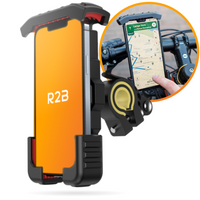No Products in the Cart

What should you pay attention to when buying scooter gloves?
Time to read 4 min
Time to read 4 min
Scooter gloves are an essential piece of gear, especially when riding in cold or rainy conditions. They keep your hands warm, provide grip and protect your skin in the event of a fall. But what should you look for when choosing a good pair of gloves? Below we discuss important factors that will help you make the best choice.
Hand protection is not only practical, but also a safety measure. When riding, your hands are exposed to wind, cold, and possible obstacles such as stones or dirt from the road. A good pair of gloves prevents you from losing your grip on the handlebars and reduces the risk of frostbitten fingers in cold conditions. Gloves can also protect your skin from serious abrasions in the event of an accident.
The material of the gloves plays a big role in comfort, durability and protection. Each material has its own advantages:
Leather gloves offer excellent protection and are very durable. Quality leather, such as cowhide or goatskin, can absorb shocks well and offers excellent grip, especially in wet conditions.
Textile gloves are often lighter and have breathable properties. They are ideal for warmer days, but may offer less protection than leather.
Mixed materials combine the best of both worlds: leather for the protective parts and textile for flexibility and ventilation. This type of gloves is suitable for daily use in various weather conditions.
A good scooter glove offers protection against both impact and abrasion. Here are some features to look for:
Reinforcements on the knuckles and palms provide extra protection in the event of a fall. Knuckle protection can consist of hard parts, such as plastic or metal, and prevents injuries in the event of an impact.
Extra layers on the palm help prevent chafing and extend the life of the gloves. Slider pads are useful for scooter gloves because they reduce impact and prevent skin chafing in the event of a slide.
Losing grip on the handlebars can be dangerous. That's why it's essential to choose gloves with a good anti-slip layer:
Silicone or rubber grip on the palm ensures you can firmly hold the handles even when your hands are wet from rain or sweat.
Tight fit without excess material helps maintain control of the handlebars. Gloves that are too loose can shift, slowing your reaction time.
Gloves should fit snugly without pinching. A glove that is too tight will restrict blood flow, while a glove that is too loose will reduce your grip. When fitting, pay attention to the following:
Snug fit without restrictions: the glove should feel like a second skin, but you should be able to move your fingers freely.
Adjustable wrist straps are useful for securing the glove properly, especially in rain or strong winds.
Avoid wrinkles or excess material that can chafe and cause discomfort during longer rides.
If you ride a lot in the rain, consider waterproof gloves. There are several materials and techniques to make your gloves water-resistant and breathable:
Waterproof materials like Gore-Tex or special coatings keep your hands dry. Make sure they are also breathable to prevent your hands from getting too warm and sweating.
Winter gloves often have a thermal lining for extra warmth and insulation. This is especially important in cold weather so that your hands do not cramp.
Just like your other clothing items, gloves are seasonal. You need light, breathable gloves for the summer and thicker, insulated gloves for the winter:
Summer gloves are often made of lighter materials such as textile or a combination of leather and mesh. They provide ventilation and comfort in warm temperatures.
Winter gloves are insulated with materials such as fleece or Thinsulate. Some models are waterproof and have an extra layer for heat retention.
Some gloves offer useful additional features that make riding easier:
Touchscreen compatibility: This allows you to use your smartphone without removing your gloves, which is useful for navigation. Touchscreen gloves are becoming increasingly popular.
Reflective strips: These increase your visibility in the dark, which increases safety.
Adjustable wrist straps and hook-and-loop closures: These allow you to secure the gloves, helping them stay in place.
Depending on your riding style, there are different models of gloves that will suit you best:
Casual riding in the city : Choose light gloves with good grip and some basic protection. Ventilation and comfort are often more important than robust protection.
Longer rides or higher speeds : Go for gloves with better protective features, such as knuckle protection and extra reinforcements on the palm.
Sport riding : Gloves for sport riders are often tight and offer a close fit. They give you more control, but can be less comfortable for everyday use.
Test your gloves before you buy them. Pay attention to the following:
The gloves should fit snugly around your fingers and wrist, without pinching.
You should be able to bend your hand without any tension developing.
The fingers should not be too long or too short; your fingertips should just touch the edge without feeling any pressure.
To extend the life of your gloves, proper maintenance is essential:
Clean your gloves regularly , especially after rainy rides. Use mild soap and avoid direct sunlight while drying.
Condition leather gloves occasionally with a special leather product to keep the material supple and prevent drying out.
Check for tears and wear . If the protective layers are damaged, consider replacing the gloves for optimum safety.
